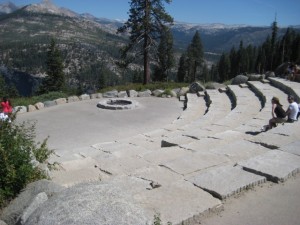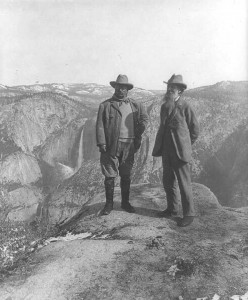Two Yosemites: An Outdoor Opera coming to a National Park near you
I recently completed the first act of my most ambitious project to date, Two Yosemites: An Environmental Chamber Opera. This project has sustained years of ideas and passions, Two Yosemites seeks to culminate history, conservation, music, drama and myth. The opera explores a pivotal moment in the history of the American environmental movement when two protean figures made a powerful alliance on the behalf of nature, also illuminating the fault lines of a society in increasing conflict with its environment.
I believe we are at a crucial moment where the arts may lead the way in creating a ‘culture of communion’ with the natural world – creating opportunities for our culture to find renewed harmony within the web of life. Collaborating with Muir scholar and actor Lee Stetson (featured on the PBS special The National Parks) I’ve adapted the libretto from his play, including numerous primary sources of Roosevelt and Muir as well as written accounts of their trip together. Though many anecdotes are historically verified, there is no way to know exactly what they said to one another–leaving room for art and myth to take over where history leaves off.
I interpret this story as a mythological quest; Roosevelt, the hero, departs for the wilderness, choosing John Muir as his ‘shaman’ or spiritual guide. Roosevelt undergoes a spiritual transformation with Muir. After meeting Muir his Presidential speeches and policy reflected this change, leaving a legacy of over twenty National Parks and Monuments – a Presidential record of conservation that has still yet to be matched. Roosevelt and Muir’s odyssey of departure-transformation-return leaves fertile ground for opera – a genre, which at its best, concerns itself with myth and the exploration of momentous questions. Contemporary operas also seek to reimagine its audience and function in contemporary society.
My vision for Two Yosemites has always been to stage the opera outdoors, at Glacier Point where Muir and Roosevelt actually camped and talked late into the night around the fire. Giving audiences and visitors an opportunity to have an historical and aesthetic experience with direct links to our past, present, and future relationship with nature. The amphitheater at Glacier Point is the perfect place for this story to come alive, providing audiences with an opportunity to reflect on their own transformation of consciousness.
We are currently collaborating with environmental organizations, the National Park Service, as well as individuals, singers, musicians to make this vision a reality.
If you would like to learn how you can be a part of this exciting and historic project please contact me via the Contact page of this website.
The premiere performance, staged on the rooftop terrace of the San Francisco Conservatory of Music, may be viewed on the Music page of this website.
Synopsis and Program Note:
May, 1903. Glacier Point, Yosemite National Park.
President Theodore Roosevelt and John Muir begin their second night camping together in Yosemite. The prologue begins with the hushed evening soundscape of Glacier Point, towering three thousand feet above Yosemite Valley, hermit thrushes (depicted by the piccolo and violins) serenade the scene. An emblematic horn solo segues Roosevelt’s declamation of the natural beauty of Yosemite and enthusiasm for being in the ‘western wilds’ with Muir. Muir shows Roosevelt a letter from their mutual friend and acquaintance, Charles Sargent, whom requests an introduction from the President to help Muir’s travels on his upcoming ‘round-the-world-journey’ (which he postponed for Roosevelt). Roosevelt reads the letter, accidentally finding some choice, critical words about himself, or rather about his friend and recently appointed Chief of Forestry, Gifford Pinchot. Though a friend of the President and a friend to the “practical” interests of conservation (i.e. timber and mining companies), Muir perceives Pinchot (and by association Roosevelt) as no friend of the forest and though apologetic at first, recedes into an impassioned diatribe–giving the President of the United States a talking-to. Roosevelt, alarmed and dismissive, squeezes in words when he can in a tense argument/duet. The two men do anything but listen to each other, hardly noticing the chorus of Yosemite (tonight depicted by our two lovely sopranos and ensemble) making hints to them to perhaps settle down and listen to the wilds.
The issue of preserving the giant trees of Yosemite and protecting the Valley as part of the National Park (in 1903 it was still controlled by the State of California) are foremost on Muir’s mind while Roosevelt speechifies on compromise. Muir eventually gets the last word, remarking to the President that “God has saved these trees from the wraths of time, but he cannot save them from fools–only Uncle Sam can do that.” For his part, Roosevelt finds a momentary pause from Muir’s assault as the hermit thrushes return (Roosevelt was an amateur ornithologist and avid naturalist).
The thrush leads the two men away from themselves and back into the wilderness. Roosevelt chides Muir a little by stating he ‘should listen more to avian music’ and quotes Walt Whitman in an offhand reference to Muir before descending into a political overture of his own (Roosevelt’s aria), mixing metaphors and remarking that ‘progress, the impulse of civilization, must find its way amid the trees.’
The music changes course into a brief interlude as the two men, in an impasse, pause for a moment in contemplation. Roosevelt’s very political response prompts Muir into a ‘story’ of two Yosemites, specifically the beautiful Hetch Hetchy Valley (Muir’s aria), Yosemite’s ‘little sister to the north’ which is under threat of being confiscated and dammed by the city of San Francisco (with help from Pinchot’s political muscle, of course). Muir’s story morphs from past to present tense, describing for Roosevelt a potentially disastrous future. The first act of the opera ends with Muir, making a plea to mankind to return to the ‘waters and the wild’ and to listen once again.


How can I see a performance of the opera? I work at Kings Canyon National Park and Sequoia National Park. Thank you
Looking for the perfect electric massager? You’ve come to the right place!
At MassageSolutions, we bring you detailed electric massager reviews to help
you make the right choice.
Our team of experts puts each electric massager to the test to offer honest and helpful reviews.
If you’re suffering from muscle tension, chronic pain, or simply want relaxation, we’ve got you covered.
Find out the best electric massagers on the market, contrast, and choose
the ideal option for you. Additionally, we offer shopping tips and tips on how
to make the most of your electric massager.
Bid farewell to aches and hello to comfort with the best electric massagers.
Explore our evaluations today!
Looking for the perfect electric massager?
Look no further! At MassageSolutions, we bring you in-depth
electric massager reviews to help you make the right choice.
Our team of experts thoroughly tests each electric massager to offer impartial and informative reviews.
Whether you are suffering from muscle tension, chronic pain,
or simply need relaxation, we’ve got you covered.
Find out the highest-rated electric massagers on the market, contrast, and pick
the ideal option for you. We also provide buying guides and
advice for how to make the most of your electric massager.
Bid farewell to tension and hello to comfort with the best electric massagers.
Explore our assessments today!
Seeking the perfect electric massager? Look no further!
At MassageSolutions, we bring you in-depth electric massager reviews to help you make the best choice.
Our dedicated professionals puts each electric massager to the test to provide you
with unbiased and informative reviews. If you’re experiencing muscle tension, chronic pain, or simply need relaxation, we’ve got you covered.
Explore the top-rated electric massagers on the market, see how they stack up, and pick the ideal option for you.
Additionally, we offer purchase guides and guidance about
how to make the most of your electric massager.
Bid farewell to tension and hello to comfort with the best electric massagers.
Explore our assessments today!
Замечательная статья! Действительно полезно узнать
о ключах для автомобилей Шкода.
У меня самого есть автомобиль Шкода, и я всегда задавался вопросом о ключей.
Ваша информация очень полезна и информативна.
Заметил упоминание о официальном дилере и сайта Skodakey.
Это действительно критично, потому что безопасность и надежность автомобильных ключей – это важнейший аспект для всех владельцев.
Я определенно учту это при замене
пультов.
Большое спасибо за информативный материал, продолжайте делиться такими интересными статьями!
Здравствуйте, уважаемые читатели блога!
Давайте обсудим процесс строительства частных домов в Москве.
Строительство частного дома – это серьезное решение, и выбор
партнера имеет решающее значение.
И вот, мы сотрудничали с ProrabDom,
и могу сказать, что это был правильный выбор.
Мы были поражены профессионализмом и опытом команды
ProrabDom.
Весь проект, начиная с первых этапов и
заканчивая финальной сдачей дома, выполнялся безукоризненно и в
срок.
Дом был построен в установленные сроки, что
было для нас важно.
Кроме того, нам очень понравилась открытая и эффективная коммуникация с командой ProrabDom.
Команда ProrabDom всегда была готова выслушать наши пожелания и предложения, и
мы чувствовали себя важными частью процесса.
Если вы планируете строительство
своего дома в Москве и ищете надежного
партнера, ProrabDom – отличный выбор.
ПрорабDom – это надежный партнер, который поможет вам сделать вашу мечту о собственном доме
реальностью.
Удачи вам во всех ваших строительных проектах!
Отличная публикация! Действительно интересно узнать больше о проектах домов и коттеджей.
Собственный уютный дом – моя давняя мечта, и ваш блог
стал для меня источником вдохновения.
Мне особенно понравилась идея индивидуальных проектов, которые учитывают функциональность
и дизайн. Такой подход дает возможность создать дом, идеально подходящий под мои потребности и предпочтения.
Сейчас я отправлюсь исследовать ваш веб-сайт Проекты Домов и Коттеджей Stroyplans.
Ожидаю с нетерпением новых статей и
советов о дизайне!
Большое спасибо за полезную информацию и вдохновение!
Сервис MasterStroy, которая предоставляет услуги по возведению частных домов в столице Беларуси, поражает.
Их профессионализм и опыт, подтверждают их квалификацию.
Я очарован их проектов, и как они умеют превращать мечты в реальность.
Каждый их проект, уникален и особенен, что делает компанию MasterStroy компанией,
которой можно довериться. Я с нетерпением
жду, чтобы они приступили к строительству моего будущего уютного уголка!
Сайт MasterStroy, которая занимается
постройке домов для частных лиц в Минске, оставляет глубокое впечатление.
Опыт и профессионализм, которыми они обладают, подтверждают их квалификацию.
Я вдохновлен их предыдущих работ, и мне нравится то, как они могут превращать
мечты в реальность. Каждый их проект, уникален и
особенен, что делает MasterStroy компанией, которой можно довериться.
Я безмерно рад, и не могу дождаться момента,
когда они приступят к воплощению моей мечты в жизнь!
Замечательная статья! Действительно захватывающе узнавать о строительстве жилья.
Моя мечта всегда заключалась в том, чтобы иметь свой собственный уютный дом,
и ваш блог мотивирует меня.
Мне особенно понравилась идея
индивидуальных проектов, которые учитывают функциональность и дизайн.
Это дает возможность создать дом,
который абсолютно подходит под мои потребности и вкусы.
Сейчас моя следующая цель
- найти больше информации на вашем сайте Проекты Домов и Коттеджей Stroyplans.
Ожидаю с нетерпением новых статей и советов о
дизайне!
Спасибо вам огромное за полезную
информацию и вдохновение!